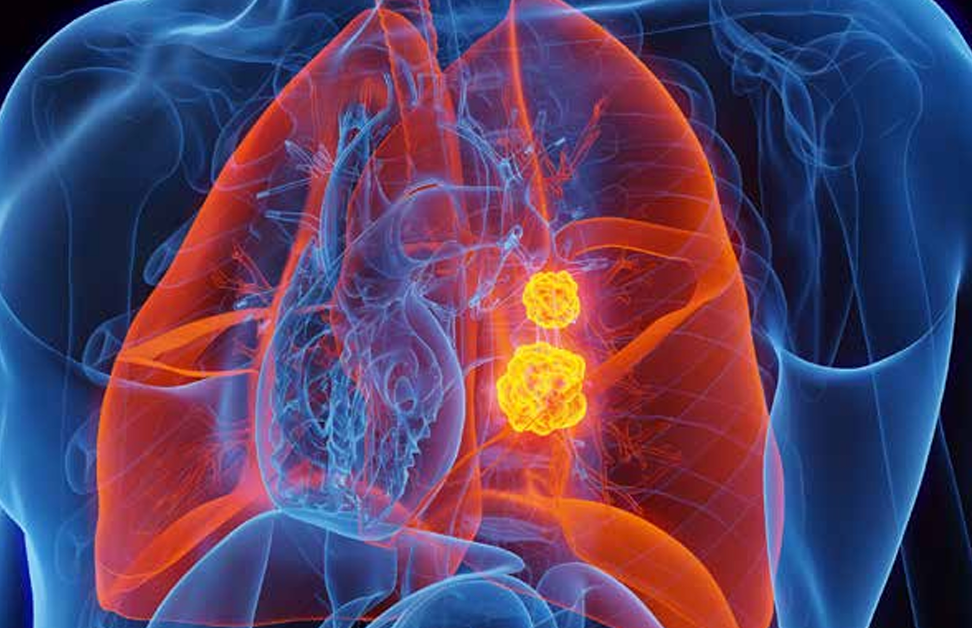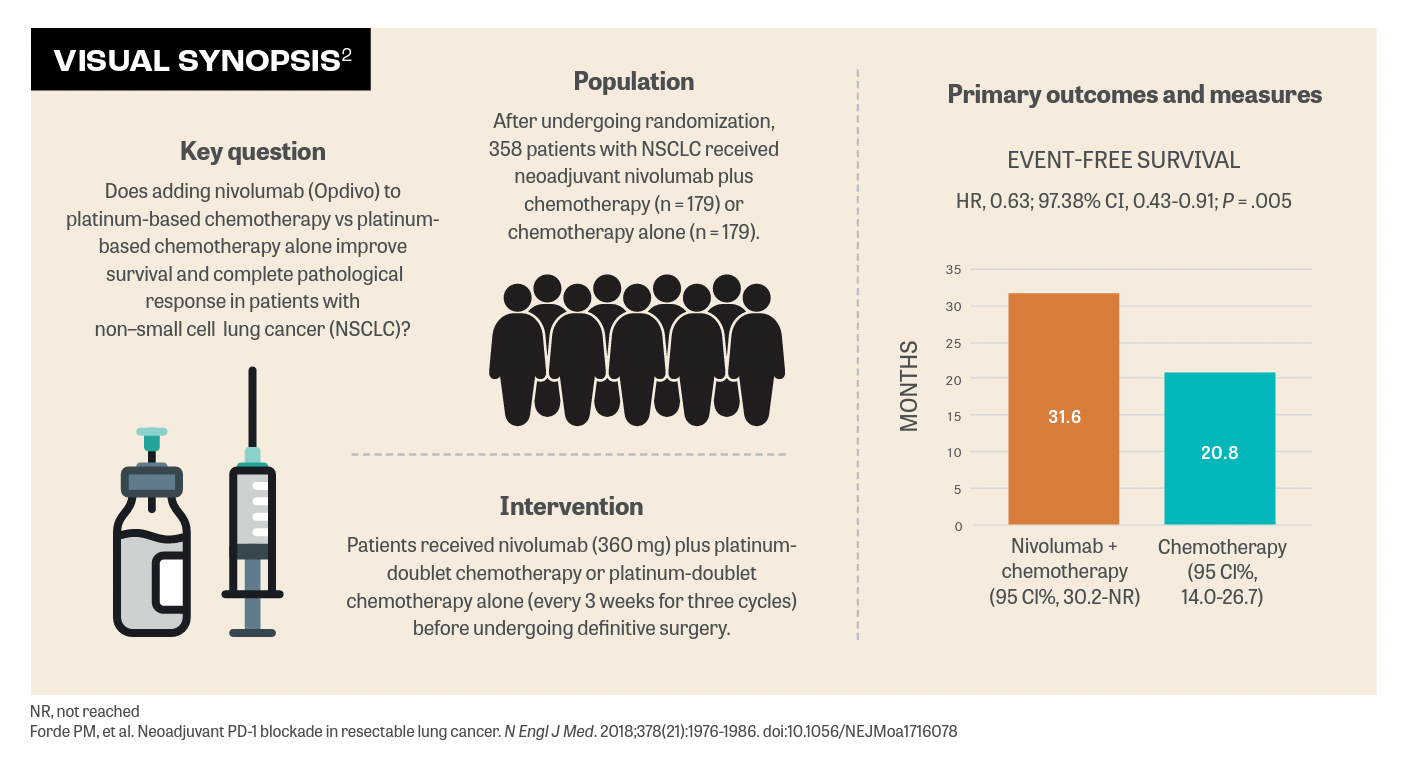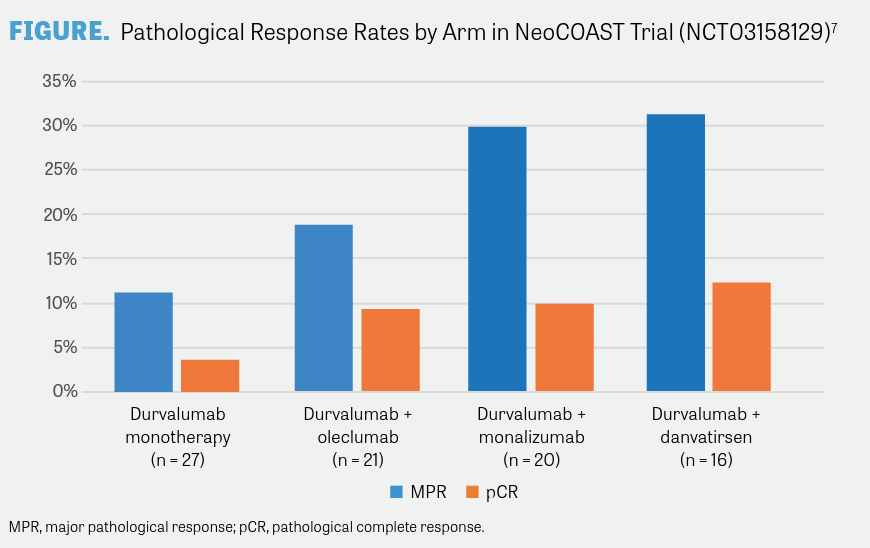Immunotherapy Combos Are Vetted in Neoadjuvant NSCLC
Tina Cascone, MD, PhD
Assistant Professor
Department of Thoracic/Head and Neck Medical Oncology
Division of Cancer Medicine
The University of Texas MD Anderson Cancer Center Houston, TX


Neoadjuvant combination regimens with immunotherapy led to improved pathologic response rates compared with chemotherapy or single-agent immunotherapy for patients with resectable non–small cell lung cancer (NSCLC). During the 20th Annual Winter Lung Cancer Conference, hosted by Physicians’ Education Resource®, LLC (PER®), Tina Cascone, MD, PhD, highlighted current research for immunotherapy combinations in the neoadjuvant setting, as well as unanswered questions for how these treatments fit into the overall course of treatment.
Cascone, an assistant professor in the Department of Thoracic/Head and Neck Medical Oncology at The University of Texas MD Anderson Cancer Center in Houston, pointed out that there is a vast discrepancy between the progress that has been made for patients with metastatic disease to date vs those with resectable disease. Notably, in the former, many new approved treatments and regimens are now in the treatment paradigm, whereas in the latter, few regimens are available.
The use of neoadjuvant or adjuvant chemotherapy provides only approximately a 5% improvement in 5-year overall survival rates (neoadjuvant HR, 0.87; adjuvant HR, 0.89) vs control group survival.1 Immunotherapy-based regimens in the neoadjuvant setting are expected to improve these rates, as immunotherapy could activate the immune system prior to surgery and enhance tumor immune infiltration. Studies of single-agent immune checkpoint inhibitors in the neoadjuvant setting have shown safety and activity for patients with resectable NSCLC, but response rates have been modest.
In a phase 2 trial (NCT02259621), neoadjuvant nivolumab (Opdivo) induced a major pathological response (MPR) in 45% of patients with untreated, surgically resectable, early NSCLC; complete pathological responses (pCRs) were reported in 15% (VISUAL SYNOPSIS).2

A phase 2 study (NCT02904954) of neoadjuvant durvalumab (Imfinzi) in patients with early-stage NSCLC showed an MPR rate of 6.7%. However, when stereotactic radiotherapy was added, the MPR rate increased to 53.3% (odds ratio, 16.0; 95% CI, 3.2-79.6; P < .0001).3 Therefore, investigators turned to combination regimens to improve outcomes.
The NEOSTAR trial (NCT03158129) was the first randomized trial to explore the use of nivolumab with ipilimumab (Yervoy) in the neoadjuvant setting for patients with previously untreated, resectable stage I to IIIA NSCLC. Patients received either nivolumab monotherapy or nivolumab with ipilimumab prior to surgery and standardof-care adjuvant therapy.
With monotherapy, the MPR rate was 22% and the pCR rate was 9% compared with 38% and 29%, respectively, with the immunotherapy doublet. Among resected patients, the MPR rate was 24% with single-agent nivolumab vs 50% with nivolumab plus ipilimumab, and the pCR rate was 10% with nivolumab alone and 38% with added ipilimumab.4 “[This is] a highly encouraging pCR rate if we think about [a] historical control of 4% pCR with chemotherapy,” Cascone said.
Additionally, following surgery, the 30-day mortality rate with nivolumab and ipilimumab was 0.0% and 2.7% at 90 days, which also compared well with historical controls.5 However, neoadjuvant immunotherapy can be associated with the development of nodal immune flare, which could prevent a patient from going on to receive surgery if it is not distinguished correctly from nodal progressive disease. Sixteen percent of patients developed nodal immune flare with noncaseating granulomas after treatment with an immune checkpoint inhibitor in the NEOSTAR trial compared with 0 cases seen with chemotherapy.6
NeoCOAST (NCT03794544) was a randomized phase 2 window-of-opportunity platform trial to analyze possible combinations with durvalumab for patients with resectable, early-stage NSCLC. Durvalumab was investigated as a monotherapy and in combination with the anti-CD73 monoclonal antibody oleclumab, the anti-NKG2A blocking monoclonal antibody monalizumab, or the anti-STAT3 antisense oligonucleotide danvatirsen.

The danvatirsen combination arm received a 7-day lead-in period of danvatirsen, but all other arms received 1 cycle of treatment prior to surgery.7 “The goal here was not to statistically compare the primary end point of MPR but to seek a signal of efficacy to bring the best combination forward into the randomized setting,” Cascone said.
The monotherapy arm showed an MPR rate of 11.1% and a pCR rate of 3.7%. Durvalumab and oleclumab induced an MPR rate of 19.0% and a pCR rate of 9.5%. Durvalumab and monalizumab led to an MPR rate of 30.0% and a pCR rate of 10.0%. Durvalumab and danvatirsen showed an MPR rate of 31.3% and a pCR rate of 12.5% (FIGURE7).
The randomized phase 3 CheckMate 816 trial (NCT02998528) investigated a combination of nivolumab and chemotherapy in comparison with chemotherapy alone or nivolumab plus ipilimumab prior to surgery, followed by adjuvant chemotherapy with or without radiotherapy in patients with resectable stage IB to IIIA NSCLC. Results from the third arm have not yet been released.8
In comparing the first 2 arms, nivolumab plus chemotherapy led to a pCR rate of 24% compared with 2.2% with chemotherapy (odds ratio, 13.94; 99% CI, 3.49-55.75; P < .0001). The median event-free survival (EFS) was 31.6 months with the combination compared with 20.8 months with chemotherapy alone (HR, 0.63; 97.38% CI, 0.430.91; P = .0052), with EFS rates of 64% vs 45%, respectively, at 24 months.
The median EFS in patients who achieved a pCR was not reached in those who received the combination and 26.6 months in those who did not achieve a pCR (HR, 0.13; 95% CI, 0.05-0.37), whereas in the chemotherapy arm, the median EFS was not reached and was 18.4 months for those who did and did not achieve a pCR, respectively. Cascone noted that even patients who did not achieve a pCR but received nivolumab did appear to do better long-term than those who received only chemotherapy. Eighty-three percent of the nivolumab and chemotherapy arm were able to undergo surgery compared with 75% in the chemotherapy arm.
“CheckMate 816…led to a new standard of care for our patients with resectable disease,” Cascone said. Following the results of the study, the FDA approved the use of nivolumab and platinum-doublet chemotherapy for adult patients with resectable NSCLC in the neoadjuvant setting, the first approval in this setting.9
“The question that keeps coming up that we’re all waiting on an answer for [is]: Is the neoadjuvant nivolumab plus chemotherapy sufficient to potentially cure our patients or will we see benefit by adding an adjuvant component? This is a question that will be answered with perioperative trials,” Cascone said.
“The potential benefit of the perioperative approach…we can continue the treatment throughout the surgical setting, and we can enhance immune killing of micrometastatic disease,” she said, pointing to the randomized phase 2 NADIMII trial (NCT03838159), in which patients received neoadjuvant nivolumab and chemotherapy or chemotherapy alone, followed by surgery and adjuvant nivolumab. In the nivolumab and chemotherapy arm, the pCR rate was 36.8% compared with 6.9% with chemotherapy alone (odds ratio, 7.88; 95% CI, 1.70-36.51; P = .0068), and the MPR rates were 52.6% and 13.8%, respectively (odds ratio, 6.94; 95% CI, 2.14-22.52; P = .0012).10
Additional arms are being investigated in the NEOSTAR platform trial, including 1 arm looking at the use of nivolumab and ipilimumab with chemotherapy. The randomized phase 2 NeoCOAST-2 trial (NCT05061550) is also being launched to explore the use of neoadjuvant durvalumab and oleclumab vs durvalumab and monalizumab, followed by surgery and the same combinations in the adjuvant setting for patients with resectable stage IIA to IIIA NSCLC. Cascone also pointed to the Lung Cancer Mutation Consortium LEADER screening trial (NCT04712877) for selecting possible neoadjuvant studies for patients with oncogene-driven early- stage NSCLC.
REFERENCES
1. NSCLC Meta-analysis Collaborative Group. Preoperative chemotherapy for non-small-cell lung cancer: a systematic review and meta-analysis of individual participant data. Lancet. 2014;383(9928):1561-1571. doi:10.1016/S01406736(13)62159-5
2. Forde PM, Chaft JE, Smith KN, et al. Neoadjuvant PD-1 blockade in resectable lung cancer. N Engl J Med. 2018;378(21):1976-1986. doi:10.1056/NEJMoa1716078
3. Altorki NK, McGraw TE, Borczuk AC, et al. Neoadjuvant durvalumab with or without stereotactic body radiotherapy in patients with early-stage non-small-cell lung cancer: a single-centre, randomised phase 2 trial. Lancet Oncol. 2021;22(6):824-835. doi:10.1016/S1470-2045(21)00149-2
4. Cascone T, William WN Jr, Weissferdt A, et al. Neoadjuvant nivolumab or nivolumab plus ipilimumab in operable non-small cell lung cancer: the phase 2 randomized NEOSTAR trial. Nat Med. 2021;27(3):504-514. doi:10.1038/ s41591-020-01224-2
5. Sepesi B, Zhou N, William WN Jr, et al. Surgical outcomes after neoadjuvant nivolumab or nivolumab with ipilimumab in patients with non-small cell lung cancer. J Thorac Cardiovasc Surg. 2022;164(5):1327-1337. doi:10.1016/j. jtcvs.2022.01.019
6. Cascone T, Weissferdt A, Godoy MCB, et al. Nodal immune flare mimics nodal disease progression following neoadjuvant immune checkpoint inhibitors in non-small cell lung cancer. Nat Comm. 2021;12(1):5045. doi:10.1038/s41467021-25188-0
7. Cascone T, García-Campelo R, Spicer J, et al. NeoCOAST: open-label, randomized, phase 2, multidrug platform study of neoadjuvant durvalumab alone or combined with novel agents in patients with resectable, early-stage non-smallcell lung cancer. Presented at: American Association for Cancer Research Annual Meeting 2022; April 8-13, 2022; New Orleans, LA.
8. Forde PM, Spicer J, Lu S, et al; CheckMate 816 Investigators. Neoadjuvant nivolumab plus chemotherapy in resectable lung cancer. N Engl J Med. 2022;386(21):1973-1985. doi:10.1056/NEJMoa2202170
9. FDA approves neoadjuvant nivolumab and platinum-doublet chemotherapy for early-stage non-small cell lung cancer. FDA. March 4, 2022. Accessed February 16, 2023. https://bit.ly/41napdd
10. Provencio-Pulla M, Nadal E, Gonzalez Larriba JL, et al. Nivolumab + chemotherapy versus chemotherapy as neoadjuvant treatment for resectable stage IIIA NSCLC: primary endpoint results of pathological complete response (pCR) from phase II NADIM II trial. J Clin Oncol. 2022;40(suppl 16):8501. doi:10.1200/JCO.2022.40.16_suppl.8501

Bispecific Antibodies and ADCs Deliver a Futuristic Horizon Across Lung Cancer Settings
October 23rd 2024Recent advancements in protein engineering, especially antibody-drug conjugates, show promise in lung cancer treatment, with ivonescimab outperforming pembrolizumab in PD-L1-positive advanced non-small cell lung cancer.
Read More